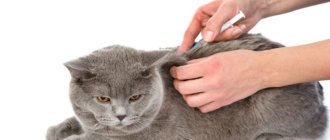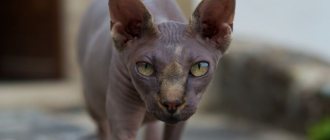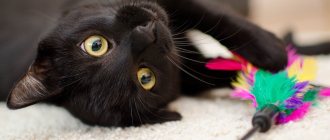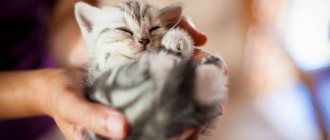Stages of a cat's life cycle
The life of any cat can be divided into several stages.
Infancy (from birth to six months)
The first six months of a baby’s life are the most significant and eventful. Ten days after birth, these are blind sucklings, whose whole world is concentrated in the warmth of the mother’s body and the nipple with milk.
By two months, kittens become quite independent, begin to feed on their own, and learn to use a litter box.
Until three or four months, the pets usually do not leave the nursery and the mother. From four to six, they resemble playful children on the cusp of adolescence.
Youth (from six months to two years)
In almost all breeds, by six months the kitten is at the beginning of puberty. Physically, he is already quite developed, almost independent.
Usually at one year the female is already able to give birth and feed kittens, although it is better if pregnancy occurs a little later, at least at 18 months. Cats mature more slowly - up to one and a half years, and in some breeds up to two or three years.
Youth (three to six years old)
Animals are considered conditionally young when they are between two and six years old. This age approximately corresponds to 20-40 years of a person. It is at the age of six that it is customary in nurseries to remove an animal from breeding.
But with good care, pets are active, healthy and capable of producing full-fledged offspring for much longer - at least up to seven to ten years.
Maturity (seven to ten years)
A cat from seven to ten years old is considered a mature individual. About the same as a person aged 40-55 years old. The animal is in the prime of life, behaves calmly and reservedly.
Older cats (eleven to fourteen years old)
From 11 to 14 years old, the cat is in old age, corresponding to human 55-70 years. If the pet does not suffer from any chronic diseases, then neither he nor the owner will have any special problems in life. Sleep time increases, whims in choosing food may appear, and there is no particular desire for outdoor games.
Old age (over fifteen years)
Pets over 15 years old can be considered 80 year olds. They are calm, unhurried, affectionate, need the attention and care of their owner, and express their devotion more clearly.
This division into age groups is very arbitrary. Many animals at 15 years old are still vigorous, playful and active. There is a known cat of the Nibelung breed that lived 36 years. She gave birth to and nursed her last kittens at 28. By the way, read about long-lived cats on our portal.
Factors influencing the duration of the “cat eyelid”
Of course, the better conditions are created for life, the longer it will last. But unfortunately, other factors also influence the measured period. We have already mentioned that cats, like people, in the apt expression of M. Bulgakov, “sometimes suddenly die,” but there are other points that affect the life expectancy of an animal.
Breed affiliation
Perhaps the connection between life expectancy and cat breed is shrouded in the greatest number of myths. To seriously talk about the relationship between these two concepts is the same as looking for the reasons for different life expectancies of people in their nationality.
According to official data from the United Nations, the population of the Central African Republic has the lowest life expectancy, and the residents of Switzerland have the highest. In absolute terms, these indicators differ from each other by almost two times - 45 years versus 82.7. But we all understand perfectly well that the reason for such an impressive gap lies not in biological differences between people (skin color, skull structure, etc.), but solely in their living conditions.
Most veterinarians agree that breed has no effect on the average lifespan of cats. However, some clarify an important detail: artificially bred breeds, on average, live shorter than their counterparts, since they have a tendency to certain hereditary pathologies.
Photo gallery: breeds based on natural mutations
I would like to clarify on my own behalf. Not every artificially bred breed is “problematic” in terms of longevity. Poor heredity can be characteristic of breeds based on natural mutations (sphinxes, rexes, fold-eared, tailless, short-legged cats), as well as those in the breeding of which inbreeding was illiterately used. Sometimes oriental cats (Siamese and Orientals) are noted to be long-lived, but such a statement does not seem to be sufficiently substantiated. Yes, my Thai cat lived to a ripe old age, and I decided to euthanize her when the animal simply could no longer move independently, could not see anything, walked under itself and, apparently, suffered greatly from a slowly growing tumor of the mammary gland (as the veterinarian told me, operable, but general anesthesia for an 18-year-old animal would be tantamount to death). However, I don’t think that such a respectable age was “gifted” to my cat by her breed. Rather, it was a matter of initially good health and a very calm character: the cat spent the last ten years of its life in a state of dormancy almost 24 hours a day, sluggishly waking up only to eat, relieve itself and slightly stretch. By the way, regarding Abyssinian cats, classified as breeds with a low life expectancy, I can also make my own assumption. Abyssins are real fidgets. All the abiks I met were the complete opposite of my phlegmatic Thai. At the risk of causing condemnation (probably partly fair), I confess that over the past five years I have had to bury three Abyssinians, two of which, despite all the precautions taken, managed to fall out of the window, one of which was just a kitten, and the second was quite an adult four-year-old cat. Returning to the arithmetic mean, there is no doubt that the percentage of survival to old age in such breeds is relatively low.
Abyssins are real fidgets
Rating of long-lived breeds
The rating of long-lived cat breeds proposed below is based on data from various sources and reviews from owners, but you should still be very skeptical about it.
Life of a street and indoor cat
Life expectancy is affected by habitat. Well-groomed and caressed domestic cats live much longer than their street counterparts. The latter have to survive, get food, and hide from the cold in winter. In the cold, death from hypothermia overtakes animals quite quickly.
Kittens born in the basement or on the street die in the first months of life in 90% of cases. The reason for this is weakened immunity, lack of heat and viral diseases. Only the strongest survive, but they have yet to prove their strength in street fights. It is not surprising that they have a short life span - few live up to 7 years, and a 10-year-old street cat will be considered a long-liver.
Animals that end up outside from home find themselves in even worse conditions. Most often, the owners refuse them, indifferently throwing them away like an unnecessary rag. The chances of living at least a year on the street for cats unadapted to such conditions are negligible.
The life of a pet is a different matter. There is good food in the bowl, a warm bed in the room. Vitamins and vaccinations protect against diseases; at the slightest deviation, a caring owner will take all measures to restore the pet’s health.
How old does a cat live by human standards?
There are special tables that draw a parallel between the age of an animal and a person. No one dares to use such comparisons for serious research - they do not provide a true picture of development. Domestic cats live according to their own natural, not invented, schedule.
Each stage of a cat’s life (childhood, adolescence and beyond) begins and ends at a time that depends only on the breed’s qualities.
- Large Maine Coons mature only at the age of 4-5, and by this time the Scottish Fold has already lived almost half of his life.
- The Siberian cat is also known for its long youth, but at half a year it is already ready to bear offspring.
- Animals from the Thai group do not live long and mature quickly - it is completely incorrect to compare them with other breeds.
This table should be viewed solely for educational purposes in order to understand how long a cat can live at home and what level of the age ladder it is at.
| Cat | Human |
| 1 month | 1.7 years |
| 2 months | 3.5 years |
| 3 months | 5 years |
| 4 months | 7 years |
| 5 months | 8.5 years |
| 6 months | 10 years |
| 1 year | 15 years |
| 1.5 years | 20 years |
| 2 years | 24 years old |
| 3 years | 28 years |
| 4 years | 32 years |
| 5 years | 36 years |
| 7 years | 44 years old |
| 10 years | 56 years old |
| 12 years | 65 years old |
| 15 years | 76 years old |
| 17 years | 83 years old |
| 20 years | 90-100 |
What affects the life expectancy of cats
With proper care and the absence of genetic or chronic diseases, many indoor cats can live up to 20 years or more. The average life expectancy is 15-17 years, with spayed and neutered animals living 2-4 years longer.
Factors that reduce life expectancy
First of all, it is the habitat. Adequate and regular nutrition, absence of temperature changes, these factors significantly affect life expectancy. Unbalanced nutrition - food from the owner's table, cheap food that does not contain the required amount of nutrients and vitamins, often leads to the development of endocrine diseases and the premature death of the pet.
Also, the period depends on the breed. Genetic predisposition can be traced, as a rule, only in purebred animals. Thus, British cats easily live up to 15 years, and Persian cats - up to 20, but “classic” and “extreme” Persians do not have such longevity and rarely live even up to 15 years. However, breed itself is not an indicator of longer life. Since these cats often have genetic defects that can be caused by inbreeding. For this reason, for example, it is dangerous to knit “Scots” and “British”.
Sexual instinct is another factor influencing life expectancy. Outdoor cats may go into heat three times a year, resulting in pregnancy. Childbirth somewhere in the basement, feeding and pregnancy again greatly depletes the body, doomed to a half-starved existence. The result is a short life.
In domestic unsterilized cats and female cats, hormonal surges and the inability to realize natural instincts can lead to diseases, so in this case, sterilization actually prolongs their life.
The allotted period can be reduced by:
- lack of vaccination and preventive measures;
- free walking, which can end in death under the wheels of a car, a fight with a dog or street cat;
- infection with infectious diseases.
Factors that increase life expectancy
Important factors that will help your pet live as long as possible are:
- Proper nutrition. Food must be balanced, no matter whether it is natural or industrial food. The pet must receive the necessary vitamins and minerals. Feed must be chosen at least at the premium or super-premium level.
- Mandatory and timely vaccination, regular preventive examinations and immediate contact with a veterinarian in case of any deviations in the health and behavior of the pet.
- Sterilization or castration, after which you need to adhere to a special diet.
- Protection from dangers. For domestic cats, this is, first of all, the street, open windows and vents. It is advisable to exclude self-walking and cover the windows with special nets (mosquito nets will not help, you need an anti-cat net).
Regular removal of parasites and preventive treatment will have a positive effect on the health of the animal, and therefore on its life expectancy. Even if the cat has never gone outside in its life, it needs to be treated for fleas and helminths once every 3 months.
Factor table
| Wednesday | Domestic cats are less susceptible to viral diseases and are protected from injury. |
| Nutrition | When balanced with essential vitamins and minerals, it significantly prolongs life. |
| Genetic predisposition | Many artificially bred breeds are susceptible to some kind of disease. |
| Sterilization | Neutered cats do not suffer from reproductive pathologies and are not exposed to stress; sterilized cats live longer than those who often gave birth to kittens. |
| Stress | Street cats are constantly exposed to stress from cold, hunger, and dangers; domestic animals have a calmer life. |
| Predisposition to chronic diseases | If you start treatment in the early stages of the disease, you can significantly prolong the life of your pet; without help, animals with diabetes do not live longer than 4 years, with urolithiasis - longer than 5. |
How long do castrated and sterilized cats live?
According to doctors' observations, these procedures prolong life by 2–4 years. The essence of the operations is different. During castration, the ovaries of females and the testes of males are removed. After this procedure, the production of testosterone and estrogen stops. Animals stop suffering from hormonal changes, become calmer, are less likely to be injured, and do not suffer from infections that are transmitted during mating. If the operation is performed before the onset of puberty, the risk of malignant neoplasms of the mammary glands and prostate is reduced.
During sterilization, the doctor tightens the spermatic ducts of males, the fallopian tubes of females, and sometimes removes the uterus. Subsequently, the animal avoids diseases of this organ: endometritis, tumors, pyometra, polycystic disease. Such an operation does not affect behavior, but animals will not be able to reproduce. The body of females does not wear out from frequent pregnancies, childbirth, and feeding kittens.
The life and health of a cat depends on the ability to be treated in a clinic by a qualified doctor.
Table of average life expectancy by breed, features and diseases
| Breed | average life expectancy | Characteristic diseases and features |
| Persian | 15-20 | “Exotics” live longer than the “classical” and “extreme” Persians.
|
| Siamese | 15-20 | “Purebreds” are more likely to develop diseases than mixed breeds; there may be problems with the kidneys and eyes.
|
| British | 12-15 |
They rarely suffer from cancer, have good immunity, it is important to maintain an active lifestyle and feed them with high-quality food. |
| Scottish Fold (Scottish Fold) | 15-20 |
They have good immunity, but it is important to choose the right diet to maintain the cat’s vital activity. |
| Siberian | 15-17 |
However, 25 years is not the limit for a “Siberian” if you keep your pet properly, since it has no tendency to develop genetic diseases. |
| Russian blue | 12-16 | A domestic cat can live longer with care and affection if it is regularly shown to a veterinarian and its nutrition is properly organized.
|
| Abyssinian | 15-17 |
It is important to regularly monitor your pet's health and take your pet to the veterinarian. |
| Bengal | 12-15 |
One of the strongest and hardiest breeds, it is only important to feed and care for them correctly. |
| Sphinx | 12-15 |
With the right approach to maintenance, it can live more than 20 years, and even at such a respectable age it has excellent immunity. |
| Maine Coon | 14-16 |
|
Maine Coon
Life expectancy of barn cats
Stray cats live much shorter lives, which is due to their unfavorable habitat. On average, their life expectancy is 6 years. Street animals have to constantly be in a state of stress, wary of attacks by stray dogs and avoiding other situations that pose a danger. They often fall under the wheels of cars.
Yard cats are more susceptible to various diseases than domestic pets, which can be contracted from other stray animals. Quite often they suffer from poisoning because, due to hunger, they eat food that is not suitable for consumption.
Table of maximum life expectancy by breed
The Guinness Book of Records contains many records for life expectancy in cats. However, for most pets, some pattern can be deduced.
| Maximum age (years) | Cat breeds |
| 20 |
|
| 19 |
|
| 18 |
|
| 17 |
|
| 16 |
|
| 14 |
|
Average life expectancy of male cats depending on breed
Different types of cats have different genetic predispositions. Whether a cat belongs to a particular breed largely affects its life expectancy. It has been noticed that animals of oriental breeds have good health, they are more resilient, and therefore live longer than others. But representatives of other cat breeds can also have a fairly long life.
Table: dependence of the average life expectancy of a cat on its breed
| Cat breed name | Life expectancy, years |
| American Shorthair, Siamese, Manx Tailless, Thai | 18‒20 |
| Abyssinian, Maine Coon, Japanese Bobtail, Australian Smoke, Devon Rex, Neva Masquerade, Asian Tabby | 15‒18 |
| Persian, Sphynx, British Shorthair, Bohemian Rex, Yorkie Chocolate, American Bobtail, Cymric, Scottish, Selkirk Rex, Ural Rex | 12‒15 |
| Russian Blue, Exotic Shorthair, Snow Shoe, Bombay | 10‒12 |
Although the average lifespan of cats rarely exceeds twenty years, there are exceptions. Such representatives of the cat family can be called very happy pets.
The oldest cat, Nutmeg, was 32 years old when they decided to euthanize him.
Not every animal is capable of crossing the 20-year mark, even with excellent care. However, it will largely depend on the owners of cats and cats how many years their pet will live in the world.
What can you do to prolong your cat's life?
Don’t despair if your pet is approaching the “average” age. Each owner can extend the life of his pet by following only a few rules:
- closely monitor the well-being of your furry friend and immediately contact a veterinarian at the slightest deviation in behavior;
- promote cat physical activity;
- do not allow self-walking;
- sterilize the animal;
- wisely select a diet containing proteins, vitamins, and minerals;
- take care and give affection to your pet, do not expose it to stress.
Approximately 30% of domestic cats suffer from chronic renal failure. It is impossible to completely cope with the disease, but if you notice it in time, you can maintain your pet’s health and significantly extend its life.
How long can cats live without food?
No living creature can live without food. The quality and regularity of food greatly influence how many years domestic cats live. A healthy individual can eat up to six times a day. There are times when an animal itself refuses to eat: when sick, during estrus, in a bad mood, in the early stages of pregnancy, during stress, and for a number of other reasons. If a cat has free access to water, she can go about five days without eating. With a longer absence of food, about two weeks, cats may experience irreversible consequences for the body.
How long do cats live in human age?
It is a mistaken belief that one year of a cat's life should be equal to seven human years. In the International Veterinary Passport, the first year of a cat’s life is equated to 18 human years, and an animal that has crossed the 20-year mark is considered a long-liver: by human standards, it is already 100 years old.
Biologists have deduced the approximate age ratio of humans and cats.
Table: how to determine the age of a cat by human standards
| Cat age, months | Person's age, years |
| 1 | 1,3 |
| 2 | 2,5 |
| 3 | 3,75 |
| 4 | 5 |
| 5 | 6,3 |
| 6 | 7,5 |
| 7 | 8,75 |
| 8 | 10 |
| 9 | 11,7 |
| 10 | 12,5 |
| 11 | 13,75 |
| Cat age, years | Person's age, years |
| 1 | 15 |
| 2 | 24 |
| 3 | 28 |
| 4 | 32 |
| 5 | 36 |
| 6 | 40 |
| 7 | 44 |
| 8 | 48 |
| 9 | 52 |
| 10 | 56 |
| 11 | 60 |
| 12 | 64 |
| 13 | 68 |
| 14 | 72 |
| 15 | 74 |
| 16 | 76 |
| 17 | 78 |
| 18 | 80 |
| 19 | 82 |
| 20 | 84 |
How long a domestic cat will live depends on the person. Having taken responsibility for the life of a pet, it is important to maintain its health: properly organize nutrition and timely vaccination.
Care and attention, treating it not as a toy, but as a full member of the family, will help prolong the life of your pet.
1111
What determines the lifespan of cats?
The lifespan of cats depends on a number of external and internal factors. Some contribute to its increase, while others contribute to its reduction.
What promotes longevity
Anything that has a beneficial effect on health is responsible for longevity. These include:
- balanced diet;
- timely vaccination, deworming and treatment against external parasites;
- absence of hormonal surges;
- safe maintenance to prevent injury;
- Regular visits to the veterinarian for preventive purposes.
All of the above are completely inaccessible to street cats. For this reason, they always die earlier than domestic ones.
What shortens years of life
Factors that reduce immunity and undermine health have the opposite effect. These include:
- living in unfavorable conditions (frequent temperature changes, dampness, unsanitary conditions);
- lack of regular nutrition, consumption of low-quality foods and lack of vitamins;
- genetic predisposition to certain pathologies;
- frequent pregnancies and childbirths;
- infection;
- free range, fraught with injury or death under the wheels of vehicles;
- frequent and prolonged stress;
- excess weight, which provokes problems with the musculoskeletal system and hormonal disorders.
All of the above can significantly reduce the allotted years by more than 2 times.
How long can a cat live without water?
Lack of water is more dangerous for cats' bodies than lack of food. The volume of fluid consumed in cats is influenced by the breed, diet, and time of year. So the British are a special species that gets by with virtually no water. If a cat eats exclusively or predominantly dry food, he needs a large amount of liquid. In the summer, even one day without moisture can seriously affect the overall well-being of the animal. During the cold season, a cat can go without water for about three days. As you can see, the lack of water can greatly affect the life expectancy of cats.











